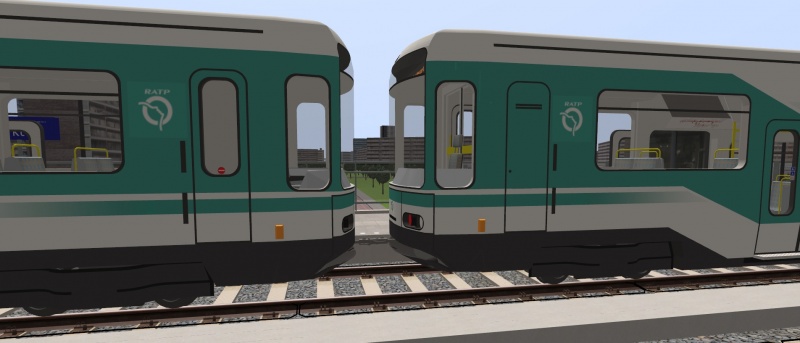TFS Trams
| Tramway Français Standard | ||||||
|---|---|---|---|---|---|---|
 | ||||||
| Series | ||||||
| Paris: 101-117, 201-216 Grenoble: 2001-2053 Rouen: 801-828 Amsterdam: 701-760 (fictional) Rotterdam: 1901-1960 (fictional) | ||||||
| Traction power supply | ||||||
| overhead wire | ||||||
| Protection | ||||||
| ATB / ZUB / ROZ | ||||||
| Download |
Note 23-12-2021: Updated to be compatible with Hageningen tram network in Metrosimulator 3.17, by adding "ROZ" (Rijden op Zicht / Drive on sight, as alternative to ATB and ZUB train protection). If you want to use these trams on this tram network and you have downloaded this package before this date, please re-download.
Note 02-01-2022: Updated as it was notic ed that the maximum speed in the above update was set too low (in order to keep up with the timetable in the Hageningen network on the lightrail lines.
The TFS tram (Tramway Français Standard) is a tram designed by Alstom to become the new standard tram model for French cities. It has been build for the networks of the cities Paris, Grenoble and Rouen. The TFS is no longer in production, having been superseded by the Alstom Citadis range of trams.
This package contains the following vehicles:
- TFS tram, Paris RATP livery
- TFS tram, Grenoble TAG (original) livery
- TFS tram, Grenoble TAG (modern) livery
- TFS tram, Rouen Metrobus livery
- TFS tram, Rotterdam RET livery (fictional)
- TFS tram, Amsterdam GVB livery (fictional)
The modern livery for the Grenoble tram can be repainted. Therefore, this tram is named "TFS Repaint" in the simulator.
The 3D model (outside only) was created in Sketchup by Seht13 on 3d Warehouse. The model has been finished (build the interior), transfered to the simulator and animated/programmed by Sjoerd Ydema.
Operation in Metrosimulator
These trains can run in service in Metrosimulator on all tramlines equiped with overhead wires.
ATP
The following automatic train protection (ATP) systems have been installed:
- RET ATB (LZB801)
- ZUB (222c)
- ROZ (Rijden op Zicht / Drive on sight)
The train will automatically select the correct system when you spawn it in one of the networks. Switch-overs between ATB and ZUB will happen automatically as you transition between systems, just like on the RET SG3 trains.
Note:The user-operable ATP selector switch option has not been installed, as it blocks the automatic ATB-ZUB vv transitions, and the AI doesn't operate this switch.
When running under ATB or ZUB train protection, the allowed speed is shown next to the speed indicator. Speeds are enforced according to the allowed speed on the track, but the display will not show a speed higher then 90 km/h, as this is the maximum in-service speed of the vehicle (in reality, it's 70 km/h. But in order to make this tram usable on the Hageningen lightrail in the simulator, and able to keep up with the timetable, the maximum speed has been raised).
When running under "ROZ" (Rijden op Zicht / Drive on sight), no allowed speed is shown in the digital display, but the indicator light on the right with the number 40 will light up. This is a suggested maximum speed for running on street level.
Train operation keys
- Shift+X - Open/close external mirrors
- Ctrl+X - Right service door
- Ctrl+Shift+X - Internal driver cabin door
- Ctrl+L - Driver desk light on/off
- Shift+L - Passenger lights on/off
- [ - Direction indicator light left on/off
- ] - Direction indicator right left on/off
- \ - Emergency lights on/off
- / and * (Numpad) - Destination display
- Ctrl+/ and Ctrl+* (Numpad) - Line number display (and changing route diagrams)
Multi unit operation
Although it doesn't happen in reality (where the couplers are for emergency towing only), in the simulator these trams can be used in service coupled together.
Repaints
In the folder "\Data\TramTFS\textures\Repaint Template backup" you will find a few repaints / templates which you can use as a basis to create your own repaints. Main purpose for this folder is to store/backup repaints you are not using at the moment. Only the file "\Data\TramTFS\textures\TFS_Repaint.png" is used by the simulator. So put the repaint you whish to use on this location under this name.
Codes for activities
To use them in your own activities, you can use these codes:
<train pack="TramTFS" file="TFS_Paris.xml"/> Paris RATP <train pack="TramTFS" file="TFS_Grenoble.xml"/> Grenoble TAG (original livery) <train pack="TramTFS" file="TFS_Repaint.xml"/> Grenoble TAG (modern livery, repaintable) <train pack="TramTFS" file="TFS_Rouen.xml"/> Rouen Metrobus <train pack="TramTFS" file="TFS_Amsterdam.xml"/> Amsterdam GVB (fictional) <train pack="TramTFS" file="TFS_Rotterdam.xml"/> Rotterdam RET (fictional)
Example of how to place a TFS tram in an activity:
<consist start="HCS2"> <train pack="TramTFS" file="TFS_Grenoble.xml"> <cab id="0" enabled="true" ai="807"/> <car id="1" scrollsign3="11"/> <car id="2" scrollsign3="11"/> </train> </consist>
Note: The "scrollsign3", for the line number displays in the Grenoble trams, must be set for each carriage individually if you want the simulator to show these upon loading the activity. You can always also set them manually once the simulation has started (in which case it effects the complete train at once). In the above example, "11" results in line 11. This "scrollsign 3" setting is not needed for variants other then the Grenoble and Repaint trams, and only affects the internal line display above the doors.
Note: Due to the build of the tram in the XML file, car id="0" is the middle carriage, and id's 1 and 2 are the end carriages. The cabviews are still id's 0 and 1.
External links
- https://en.wikipedia.org/wiki/Tramway_Fran%C3%A7ais_Standard
- https://fr.wikipedia.org/wiki/Tramway_fran%C3%A7ais_standard
- https://nl.wikipedia.org/wiki/Tramway_Fran%C3%A7ais_Standard

